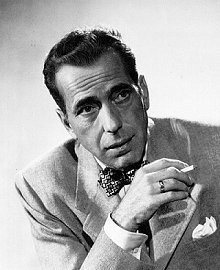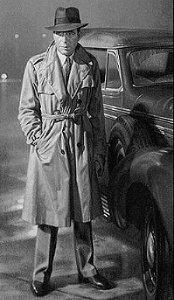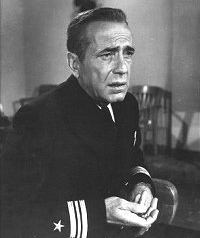 Humphrey Bogart was one of the screen's most legendary figures, a pop-culture icon to generations of movie watchers unborn when he enjoyed his initial successes. Bogart was also and extremely unlikely bet for stardom: His slight stature, weatherbeaten features, scarred lip, and withering snarl hardly qualified him in Hollywood's glamour-obsessed Golden Age. Fortunately for this talented tough guy, he was in the right place (Warner Brothers) at the right time (the onset of World War II) to win audience approval in the rugged thrillers and actions films in which that studio specialized.
Humphrey Bogart was one of the screen's most legendary figures, a pop-culture icon to generations of movie watchers unborn when he enjoyed his initial successes. Bogart was also and extremely unlikely bet for stardom: His slight stature, weatherbeaten features, scarred lip, and withering snarl hardly qualified him in Hollywood's glamour-obsessed Golden Age. Fortunately for this talented tough guy, he was in the right place (Warner Brothers) at the right time (the onset of World War II) to win audience approval in the rugged thrillers and actions films in which that studio specialized.
Born in New York City on January 23, 1899, Bogart was the son of a distinguished surgeon and actually studied medicine himself for a time before enlisting in the Navy during World War I. Caught in a blast aboard ship, he sustained facial wounds that scarred and partially paralysed his upper lip, accouting for one of his distinctive screen trademarks. A talented stage actor during the 1920s, Bogart made his screen debut in a 1930 short subject, Broadway's Like That, and alternated stints in threater and film for the next few years. His career ratcheted upward when he played vicious killer Duke Mantee in The Petrified Forest on Broadway; costar Leslie Howard insisted he recreated the role in the 1936 film adaptation, which won him a Warners contract.
Although Bogart scored in The Petrified Forest (1936) and, on loan to MGM, in Dead End (1937), again playing a killer, his home studio mired him in B pictures and secondary roles in bigger-budgeted fare. He was solid playing gangsters in 1938's Angels with Dirty Faces and 1939's The Roaring Twenties (both opposite Cagney), but was ludicrous as a zombie in 1939's The Return of Dr. X and as a Mexican bandit in the 1940 Errol Flynn Western Virginia City.
 Bogart owes his stardom to George Raft, who turned down the two 1941 roles that boosted him to the top: "Mad Dog" Earle in High Sierra and Sam Spade in The Maltese Falcon. As his box-office standing improved, Warners designed vehicles that would enable him to retain his tough-guy persona while playing sympathetic characters. Beginning with his "Rick" in Casablanca (1942), the single role for which he is best remembered (and which earned him his first Oscar nomination), Bogart etched memorable portraits as another Rick-type in To Have and Have Not (1944)--during the production of which he met and married Lauren Bacall, his fourth and final wife--as private eye Philip Marlowe in The Big Sleep (1946), an ex-GI in Key Largo (1948), the greed-crazed Fred C. Dobbs in The Treasure of the Sierra Madre (1948), a Hollywood burnout in In a Lonely Place (1950), the unstable Captain Queeg in The Caine Mutiny (1954, Oscar-nominated), an escaped killer in The Desperate Hours (1955), and a weary sportswriter in The Harder They Fall (1956), his last film.
Bogart owes his stardom to George Raft, who turned down the two 1941 roles that boosted him to the top: "Mad Dog" Earle in High Sierra and Sam Spade in The Maltese Falcon. As his box-office standing improved, Warners designed vehicles that would enable him to retain his tough-guy persona while playing sympathetic characters. Beginning with his "Rick" in Casablanca (1942), the single role for which he is best remembered (and which earned him his first Oscar nomination), Bogart etched memorable portraits as another Rick-type in To Have and Have Not (1944)--during the production of which he met and married Lauren Bacall, his fourth and final wife--as private eye Philip Marlowe in The Big Sleep (1946), an ex-GI in Key Largo (1948), the greed-crazed Fred C. Dobbs in The Treasure of the Sierra Madre (1948), a Hollywood burnout in In a Lonely Place (1950), the unstable Captain Queeg in The Caine Mutiny (1954, Oscar-nominated), an escaped killer in The Desperate Hours (1955), and a weary sportswriter in The Harder They Fall (1956), his last film.
While never noted as a comedian, Bogart was supremely funny in All Through the Night (1942), Sabrina (1954), and We're No Angels (1955), as well as The African Queen (1951), opposite Katharine Hepburn in his Oscar-winning performance as boozy riverboat skipper Charlie Allnut. A lifelong smoker, he succumbed to throat cancer on January 14, 1957. Though well respected in his lifetime, Bogart didn't attain cult status until his films were rediscovered by younger viewers in the late 1960s: His blunt, no-nonsense, cynical and world-weary manner translated into a pop-culture existentialism that spoke volumes to the alienated youth of that turbulent era, and though the antiestablishment fervor has cooled, he remains arguably the most popular male star of Hollywood's Golden Age.
--LEONARD MALTIN, from
Leonard Maltin's Movie Encyclopedia.
 As Sam Spade in The Maltese Falcon and then later as Philip Marlowe in The Big Sleep, Bogart caught the particular flavor of Hammett's and Chandler's hard-boiled style. Like Alan Ladd and Veronica Lake, Bogart works in a restricted area, with few inflections and minimal movement. With his stiff face and taught voice, his rhythmed recitation (accented by the famous lisp) of the roguish Hammett-Chandler dialogue, Bogart works in a monochromatic style. His delivery is as lean as his physique. For him, less is certainly more. And yet the actor's pared-down, straight-ahead, no-fuss manner communicates a subtle range of feeling, from waggish humor to romantic interest. Throughout both key films there are chinks in the tough-guy armor, moments when the actor drops the rigor mortis mask.
As Sam Spade in The Maltese Falcon and then later as Philip Marlowe in The Big Sleep, Bogart caught the particular flavor of Hammett's and Chandler's hard-boiled style. Like Alan Ladd and Veronica Lake, Bogart works in a restricted area, with few inflections and minimal movement. With his stiff face and taught voice, his rhythmed recitation (accented by the famous lisp) of the roguish Hammett-Chandler dialogue, Bogart works in a monochromatic style. His delivery is as lean as his physique. For him, less is certainly more. And yet the actor's pared-down, straight-ahead, no-fuss manner communicates a subtle range of feeling, from waggish humor to romantic interest. Throughout both key films there are chinks in the tough-guy armor, moments when the actor drops the rigor mortis mask.
Bogart had the perfect face for noir, a face filled with character. Though he tried, Bogart could not conceal worry or regret or the sadness that always seemd to gnaw at him. His mask is thus different from the idealized ones of Lake and Ladd, from which all human concern seems to be erased. In contrast to their unblemished facade, Bogart has a frankly homely face--a mug--and he doesn't look at all like anyone's stereotyped concept of a movie star. Our characteristic view of him is seated at a table, the inevitable drink nearby, cigarette in hand, as he stares out at the world dispassionately yet with intimations of a seething tension within. His means of expression are limited, practically to the point of abstraction, yet he radiates complexity.
As he plays them, the private eyes are men of principle, men with their own code of honor whose cynicism masks their essential integrity. It is the moreal certainty which emanates from Bogart, and the sense of shrewdness in his judgment of others, that more than anything have been responsible for the actor's mystique. As he moves from the patented Bogart, the distristful Sam Spade and Philip Marlowe, to the role of a victim in Dark Passage (1947), of a criminal in Conflict (1945), and of a crackpot in In A Lonely Place (1950), Bogart covers the noir spectrum. The neuroticism of his later performances, though, was suggested in the private eye characters, and he invariably invested his characters, even the most seemingly adjusted ones, with a strong neurotic potential.
--FOSTER HIRSCH, from Film Noir
The Dark Side of the Screen.